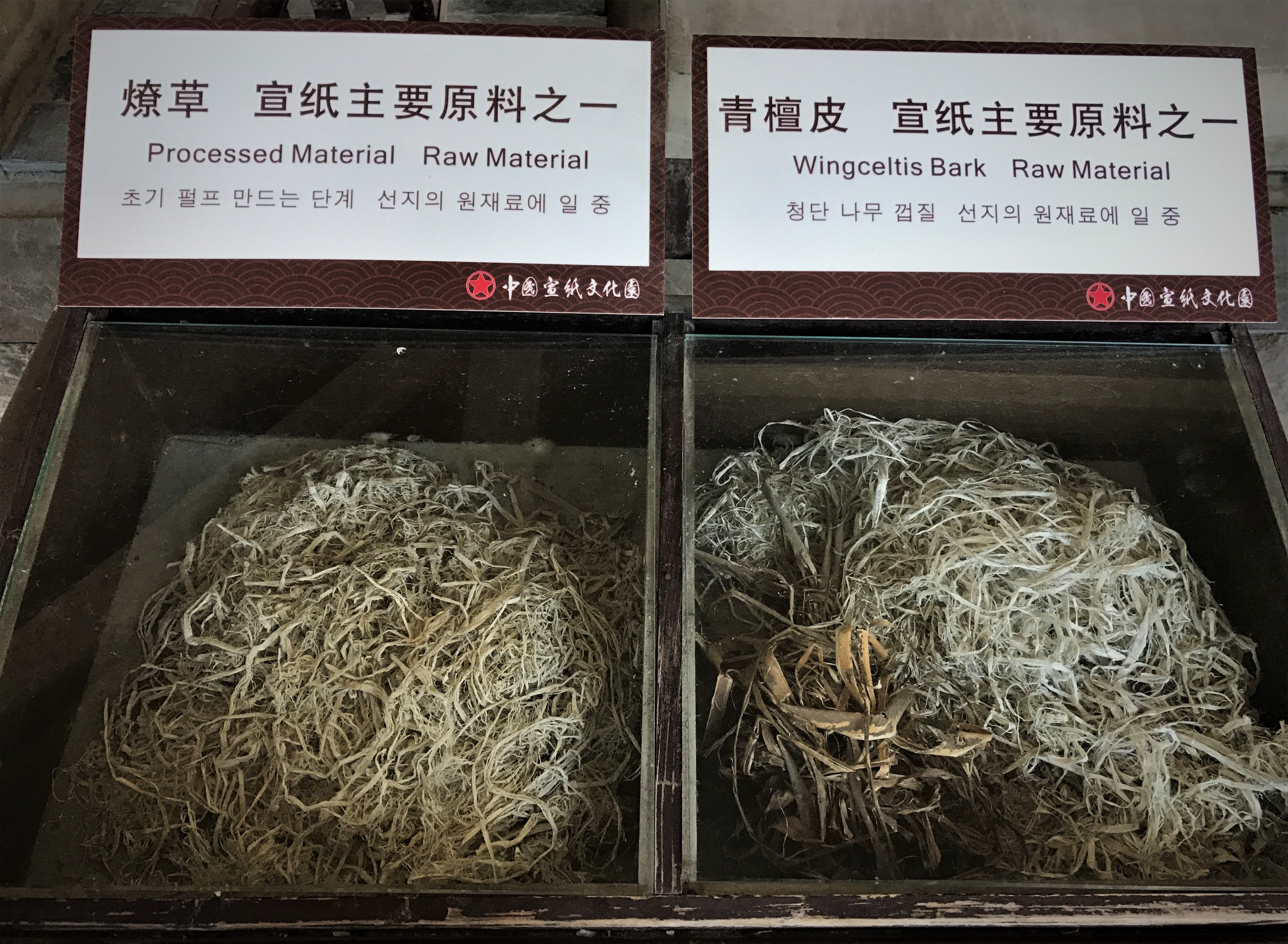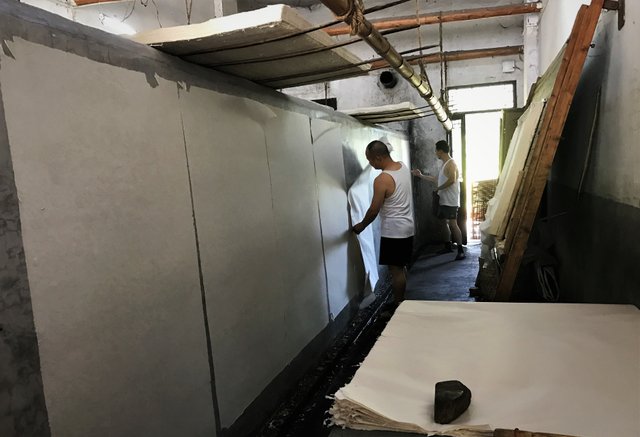Step 1: Use the stiff-hair brush to outline the shape of a lotus.
第一步:用稍硬的狼毫笔大致勾出荷花的轮廓。(其实我那两只烂笔用起来并没多大区别)
~ Freehand Style VS Gongbi Style ~
Here I apply the freehand style, also known as ink and wash painting in China. Another type of Chinese painting is called Gongbi, literally "meticulous", different from the freehand style that focuses on the general conception and rhythm, Gongbi usually depicts figurative or narrative subjects in highly detailed brushstrokes.
In ancient China, Gongbi is often practiced by artists who works for the royal court or in independent workshops. While the ink and wash painting was one of the "Four Arts" of the Chinese scholars and officials.
~ 写意 VS 工笔 ~
这里我用的是类似《小蝌蚪找妈妈》水墨动画中的写意画法,不求形同,只求神似😁。还有一种国画种类就是众所周知的工笔,在古代一般是宫廷画师或独立画匠赖以生存的饭碗。而水墨画则主要是古代的学者官员们“琴棋书画”这些雅兴中的一种,通俗点说就是吃饱了撑着没事干时用来画着玩玩的~ 还请原谅我看破红尘的粗鲁。
Step 2: Use the soft-hair brush to paint the lotus leaf, water and the base of plants.
第二步:用稍软的笔染出荷叶、池水和水草。
~ About the Paper ~
You can see that the raw rice paper is absorptive, which is good for ink or pigments to make ranges and to show textures. This kind of Shengxuan paper is widely used for Chinese calligraphy and ink paintings. Actually I feel the paper I used is like a semi-raw one, as it's not that absorptive and gets dry quickly.
Another type is called Shuxuan or Fanxuan paper, literally means alum paper. It is the raw absorbing paper coating with an alum solution. So it is not absorbing the ink or pigments, which is used for the precise layout of Chinese paintings, like the Gongbi type I talked about earlier.
A particular Chinese silk called Juan is also used by painters. This glossy fabric boasts a lustre for expressing textures in some Gongbi paintings, but silk deteriorates much faster than the 2 kinds of rice paper.
Rice paper is known as "long-lasting paper of a thousand years", with a history of over 1500 years. Most of the paintings and calligraphy works from ancient China done on rice paper are still in a great condition. It is because the paper is made of straw from the rice plant(thus rice paper) and unique Qingtan tree(Wingceltis) barks (pictured below), which contribute to the resilient texture. I once visited a paper-making factory, and I was amazed by the process of creating this wonderful medium for Chinese painting and calligraphy.


photos by @itchyfeetdonica in the Rice Paper Cutural Museum and Workshop in Anhui Province, China
~ 关于宣纸和熟绢 ~
我用的是(半)生宣纸,墨汁和颜料较容易晕染开来,所以这种纸一般用在写意画和大幅书法上。而熟宣或熟绢则是生宣纸或生绢经过一定比例的胶矾水刷制成的。因为其不渗墨色的性能而多被用来画工笔。熟宣纸有薄有厚,胶矾水含量有浓有淡,以蝉翼笺最薄,冰雪宣最厚,还有书画笺、云母笺、清水书画宣等。通常薄笺适合画淡彩,厚宣适合画重彩。熟绢比熟宣纸有光泽,工笔画面效果较好,但不容易经久保存,所谓“千年陈丝不如草”,“纸寿千年绢寿八百”。
我曾去宣纸厂参观过造纸过程,宣纸主要以青檀树皮和沙田稻草为原料(见上图),檀皮决定纸的韧性和拉力,稻草决定纸的洁白度与柔软度。当地独特的水质和青檀皮使制造出来的宣纸韧性强、耐老化、少虫蛀,寿命长,被称为“千年寿纸”,造纸工艺迄今已有1500多年历史。薄、轻、软、韧、细、白的纸张有助于书画创作时达到“墨韵万变”的效果。 根据檀皮与稻草的不同配比,宣纸又可细分为棉料、净皮、特种净皮三大类,还可按大小规格、纸面纹理分类,但今天就不扯那么多了,留待下次吧。
Step 3,4,5,6...: Draw the frog, the tadpoles and the grass with the hard-hair brush. Color the lotus flower and the frog. Use the soft-hair brush to dot the soil and to add more layers to the water and plants.
第三、四、五、六......步:画完剩下的青蛙妈妈和蝌蚪宝宝,给荷花、大片水草染色,点出更多前景的淤泥和细草。
~ About the Pigments & Ink Stone ~
As I was so involved in painting, I forgot to take pictures for each step. I only realized it when I almost finished the whole thing, haha... Sorry for that. When I was painting, I found the pigments contain more particles than the genuine Chinese paint. It's more like the Western gouache paint, so I decided to draw the frog in a more "gouache" way. That's why you don't see the Chinese-painting style frog here which resembles a dark fluffy mud fish to me.
Chinese pigments contain more glue than Western gouache paint and watercolours, making the pigment bind better to rice paper and silk. Outside of some basic traditional pigments made from natural plants and minerals without glue, other colours are made from synthetic chemicals. For example, the 5 tubes I used are synthetic versions that already contain glue.
Traditionally, to get the ink for painting, Chinese painters use a solid ink stick to rub on a stone with water. When they control the time of rubbing, various densities of ink could be obtained. The ink stone can come with many forms and sizes, which is considered as art itself. Today, most of us just buy ink in small bottles or cans, like what you see in my photo.
~ 关于颜料 & 墨砚 ~
这里因为我画得太尽兴,一时忘了拍照,等到几乎画完才想起来没有一步步拍,罪过😆,都怪我这人生太随性~。尽情挥洒泼墨的时候,我一度发现这劣质颜料颗粒很大,更像是画水粉的,再说山水画里的青蛙通常是个毛绒绒的黑团,我觉得跟泥鳅更神似,所以我画青蛙妈妈时索性放弃了写意画法,反正主角是蝌蚪宝宝们。哈哈哈,我是不是太不拘小节,画随心动了?😏
国画颜料主要是矿物和植物提取物制作的,除了十几种自然基础色外,其他颜色多为化学合成物。和水彩、水粉画颜料一样都可用水稀释,但国画颜料的水性胶含量大过水彩颜料, 而颗粒较水粉画颜料更细。国画颜料相比油画更柔和,不像油画颜料那么容易覆盖,适合小面积的涂染。 油画颜料则是矿物和化学合成物制作的,用的是松节油等植物提取油,不含水性胶。
关于墨汁,传统的做法自然是用墨条在砚台上磨,还记得古装戏里温柔磨墨的妃子或书童吗?还好我没生在古代...... 这事儿还真考验耐心~ 不禁暗暗感激发明瓶装墨汁的人。根据磨墨的时间和力道不同,墨自会产生深浅浓淡的差别,再加上水的调和作用,墨分五色,变幻无穷。砚台本身也是造型多样、材质各异,很多都是具有收藏价值的艺术珍品。古代文人墨客对砚十分重视,不仅常相随,死后还用来殉葬。米芾就对一方山形砚台爱不释手,苏东坡也爱称砚台为“石君”、“石友”。
~ About the 4 Basic Techniques ~
So I've talked about the "Four Treasures of the Chinese Study" - brushes, ink, paper and ink stone, plus the two styles of Chinese painting and differences between Chinese pigments and the western ones. Now I'd like to move on to the 4 basic brush techniques of Chinese painting: gou (outlining/contouring), cun + ca (wrinkling/texturing + rubbing), dian (dotting) and ran (coloring/dyeing). Gou is to draw lines of the basic shapes; Cun + ca is for the textures and shades of rocks, mountains, trees and plants...; Dian is to dot the moss, grass and spots on rocks; Ran is to dye the landscape to make layers. There are still so many more tips and techniques but I won't ramble on today in this post - it's already long enough. I'm more than happy if you have read along till here.
~ 关于基本技法 ~
刚才讲到笔墨纸砚这文房四宝和颜料(敲黑板......),现在继续简要聊聊中国画用笔的技法,虽然我这次画的并不是纯正的国画,只是对动画角色的再创造而已。根据古典法则,四个基本技法是“勾、皴、点、染”。“勾法”指用各异的线条表现不同形态和质感;“皴法”用来表现山石树木的质地、脉络、凹凸、阴阳、向背;“点法”是说点出山石上的苔藓、斑点等;“染法”指用淡墨或色彩将景物染出立体感。至于具体的步骤,限于篇幅就不再介绍,而且我这种疏于练习、随意放飞自我的业余水平就不瞎班门弄斧、贻害众生了。况且国画的气韵也不是一点技法就可以表现出来的,需要长期的观察、体验、修养和练习。
So that's it for today's content about Chinese painting. Hope you like it and my painting! Tell me what you think in the comments! Until next time. =)
欢迎留言分享你的想法,下次见喽~
All content by @itchyfeetdonica.
照片文字均为原创
Author: @itchyfeetdonica
Translator: @itchyfeetdonica
unbelievable amazing @cn-reader great job i like your painting. keep it up.
Downvoting a post can decrease pending rewards and make it less visible. Common reasons:
Submit
Thanks @yameen! :)
Downvoting a post can decrease pending rewards and make it less visible. Common reasons:
Submit
很棒的小蝌蚪找媽媽
Downvoting a post can decrease pending rewards and make it less visible. Common reasons:
Submit
谢谢!=)
Downvoting a post can decrease pending rewards and make it less visible. Common reasons:
Submit
@cn-reader, 嘻嘻,小可可来给你点赞啦~~~
Downvoting a post can decrease pending rewards and make it less visible. Common reasons:
Submit
@cn-reader, 艺术就应该是这样的!
BTW,嘿嘿,让 @cn-cutie.pie 可可妹子抢了首发咧...
Downvoting a post can decrease pending rewards and make it less visible. Common reasons:
Submit